S317 Biological Science: From Genes to Species TMA 03 Solution
VerifiedAdded on 2022/08/10
|9
|2503
|400
Homework Assignment
AI Summary
This document presents a comprehensive solution to the S317 Biological Science TMA 03 assignment, covering topics from genes to species. The solution addresses questions on the human mtDNA genome, including its base pair length, tRNA encoding, and protein-coding regions. It explores gene duplication processes like polyploidisation and translocation, differentiating between subfunctionalisation and neofunctionalisation. The assignment also delves into transcription, detailing the roles of RNA polymerase, promoter binding proteins, and operons, as well as the splicing process, including self and alternate splicing. Further, it examines mechanisms for measuring transcriptional accuracy, such as proofreading mechanisms at the level of RNA polymerase, translation, and tRNA selection. The final section analyzes the expression of BACE1 gene and its regulation by 3' UTR and 5' UTR regions, including the use of GFP as a positive control and luciferase assays. The solution references multiple scientific papers to support its arguments.
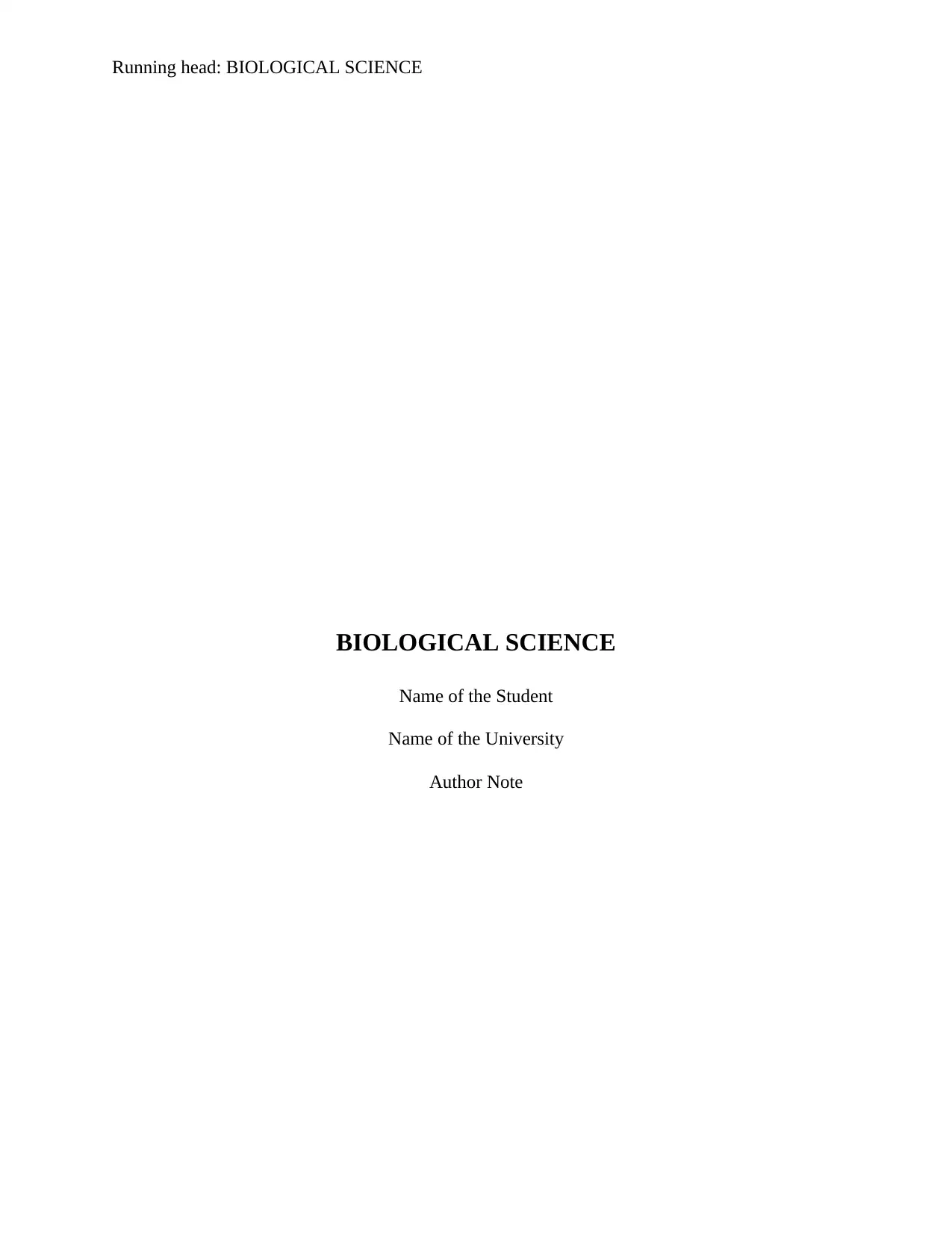
Running head: BIOLOGICAL SCIENCE
BIOLOGICAL SCIENCE
Name of the Student
Name of the University
Author Note
BIOLOGICAL SCIENCE
Name of the Student
Name of the University
Author Note
Paraphrase This Document
Need a fresh take? Get an instant paraphrase of this document with our AI Paraphraser
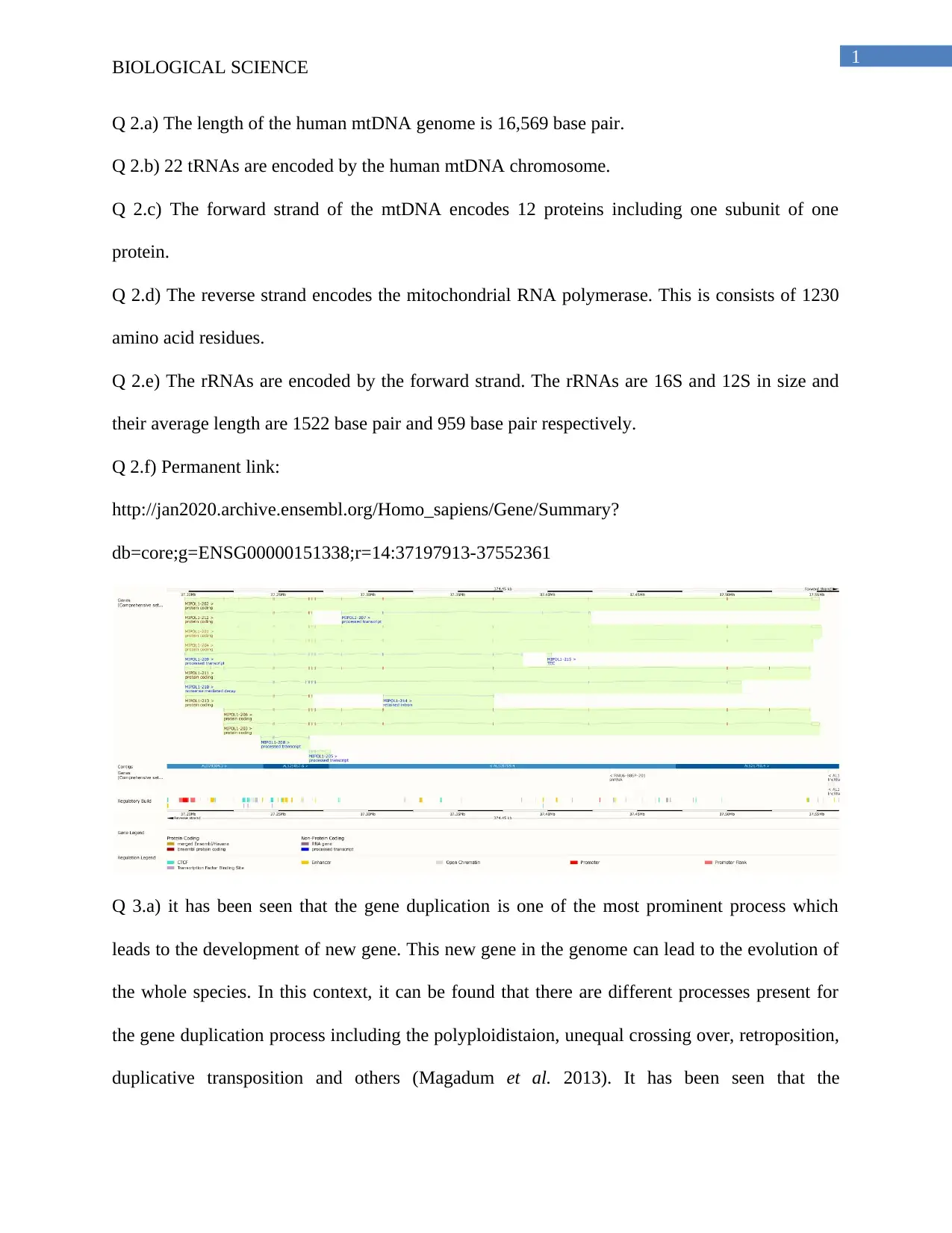
1
BIOLOGICAL SCIENCE
Q 2.a) The length of the human mtDNA genome is 16,569 base pair.
Q 2.b) 22 tRNAs are encoded by the human mtDNA chromosome.
Q 2.c) The forward strand of the mtDNA encodes 12 proteins including one subunit of one
protein.
Q 2.d) The reverse strand encodes the mitochondrial RNA polymerase. This is consists of 1230
amino acid residues.
Q 2.e) The rRNAs are encoded by the forward strand. The rRNAs are 16S and 12S in size and
their average length are 1522 base pair and 959 base pair respectively.
Q 2.f) Permanent link:
http://jan2020.archive.ensembl.org/Homo_sapiens/Gene/Summary?
db=core;g=ENSG00000151338;r=14:37197913-37552361
Q 3.a) it has been seen that the gene duplication is one of the most prominent process which
leads to the development of new gene. This new gene in the genome can lead to the evolution of
the whole species. In this context, it can be found that there are different processes present for
the gene duplication process including the polyploidistaion, unequal crossing over, retroposition,
duplicative transposition and others (Magadum et al. 2013). It has been seen that the
BIOLOGICAL SCIENCE
Q 2.a) The length of the human mtDNA genome is 16,569 base pair.
Q 2.b) 22 tRNAs are encoded by the human mtDNA chromosome.
Q 2.c) The forward strand of the mtDNA encodes 12 proteins including one subunit of one
protein.
Q 2.d) The reverse strand encodes the mitochondrial RNA polymerase. This is consists of 1230
amino acid residues.
Q 2.e) The rRNAs are encoded by the forward strand. The rRNAs are 16S and 12S in size and
their average length are 1522 base pair and 959 base pair respectively.
Q 2.f) Permanent link:
http://jan2020.archive.ensembl.org/Homo_sapiens/Gene/Summary?
db=core;g=ENSG00000151338;r=14:37197913-37552361
Q 3.a) it has been seen that the gene duplication is one of the most prominent process which
leads to the development of new gene. This new gene in the genome can lead to the evolution of
the whole species. In this context, it can be found that there are different processes present for
the gene duplication process including the polyploidistaion, unequal crossing over, retroposition,
duplicative transposition and others (Magadum et al. 2013). It has been seen that the
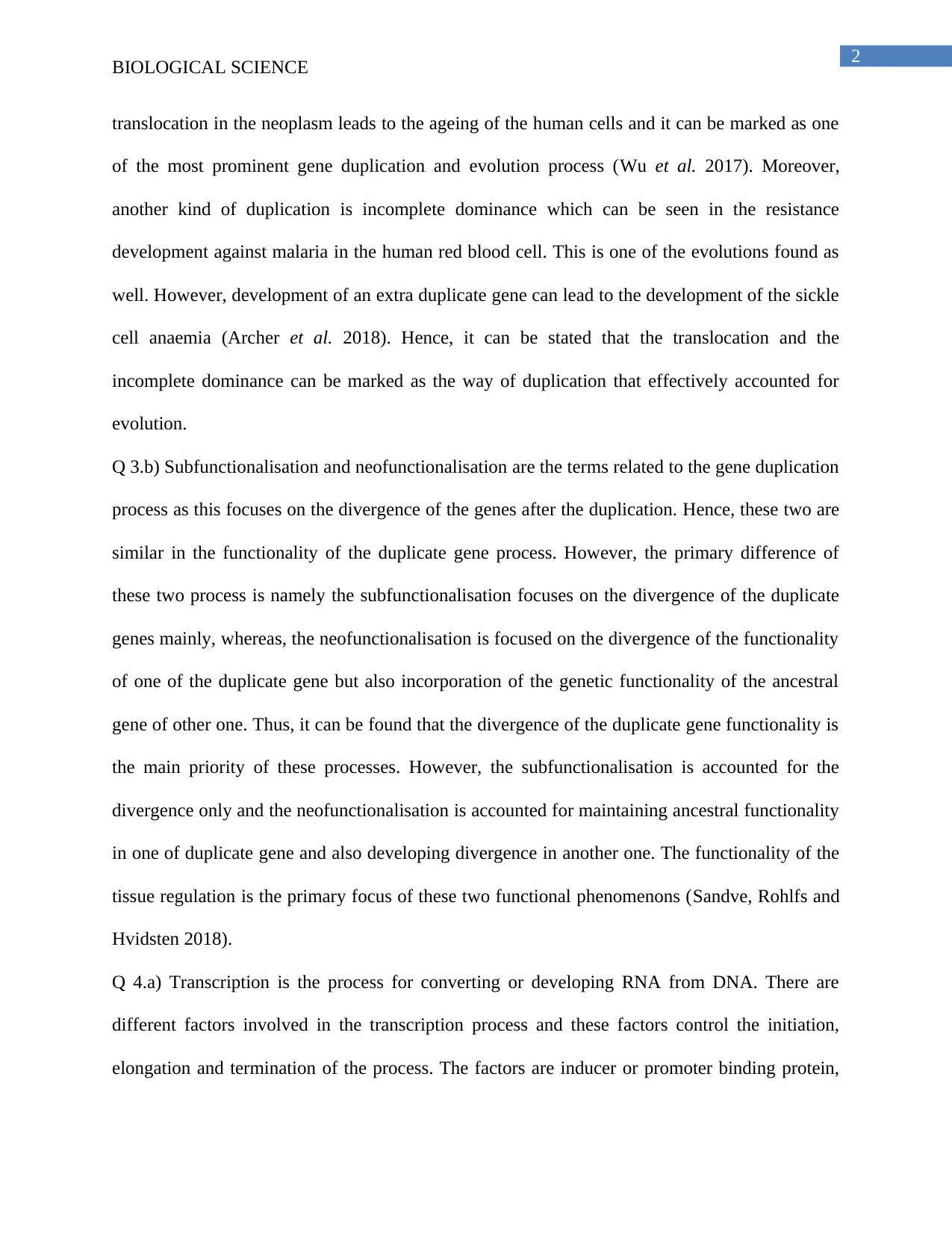
2
BIOLOGICAL SCIENCE
translocation in the neoplasm leads to the ageing of the human cells and it can be marked as one
of the most prominent gene duplication and evolution process (Wu et al. 2017). Moreover,
another kind of duplication is incomplete dominance which can be seen in the resistance
development against malaria in the human red blood cell. This is one of the evolutions found as
well. However, development of an extra duplicate gene can lead to the development of the sickle
cell anaemia (Archer et al. 2018). Hence, it can be stated that the translocation and the
incomplete dominance can be marked as the way of duplication that effectively accounted for
evolution.
Q 3.b) Subfunctionalisation and neofunctionalisation are the terms related to the gene duplication
process as this focuses on the divergence of the genes after the duplication. Hence, these two are
similar in the functionality of the duplicate gene process. However, the primary difference of
these two process is namely the subfunctionalisation focuses on the divergence of the duplicate
genes mainly, whereas, the neofunctionalisation is focused on the divergence of the functionality
of one of the duplicate gene but also incorporation of the genetic functionality of the ancestral
gene of other one. Thus, it can be found that the divergence of the duplicate gene functionality is
the main priority of these processes. However, the subfunctionalisation is accounted for the
divergence only and the neofunctionalisation is accounted for maintaining ancestral functionality
in one of duplicate gene and also developing divergence in another one. The functionality of the
tissue regulation is the primary focus of these two functional phenomenons (Sandve, Rohlfs and
Hvidsten 2018).
Q 4.a) Transcription is the process for converting or developing RNA from DNA. There are
different factors involved in the transcription process and these factors control the initiation,
elongation and termination of the process. The factors are inducer or promoter binding protein,
BIOLOGICAL SCIENCE
translocation in the neoplasm leads to the ageing of the human cells and it can be marked as one
of the most prominent gene duplication and evolution process (Wu et al. 2017). Moreover,
another kind of duplication is incomplete dominance which can be seen in the resistance
development against malaria in the human red blood cell. This is one of the evolutions found as
well. However, development of an extra duplicate gene can lead to the development of the sickle
cell anaemia (Archer et al. 2018). Hence, it can be stated that the translocation and the
incomplete dominance can be marked as the way of duplication that effectively accounted for
evolution.
Q 3.b) Subfunctionalisation and neofunctionalisation are the terms related to the gene duplication
process as this focuses on the divergence of the genes after the duplication. Hence, these two are
similar in the functionality of the duplicate gene process. However, the primary difference of
these two process is namely the subfunctionalisation focuses on the divergence of the duplicate
genes mainly, whereas, the neofunctionalisation is focused on the divergence of the functionality
of one of the duplicate gene but also incorporation of the genetic functionality of the ancestral
gene of other one. Thus, it can be found that the divergence of the duplicate gene functionality is
the main priority of these processes. However, the subfunctionalisation is accounted for the
divergence only and the neofunctionalisation is accounted for maintaining ancestral functionality
in one of duplicate gene and also developing divergence in another one. The functionality of the
tissue regulation is the primary focus of these two functional phenomenons (Sandve, Rohlfs and
Hvidsten 2018).
Q 4.a) Transcription is the process for converting or developing RNA from DNA. There are
different factors involved in the transcription process and these factors control the initiation,
elongation and termination of the process. The factors are inducer or promoter binding protein,
⊘ This is a preview!⊘
Do you want full access?
Subscribe today to unlock all pages.

Trusted by 1+ million students worldwide
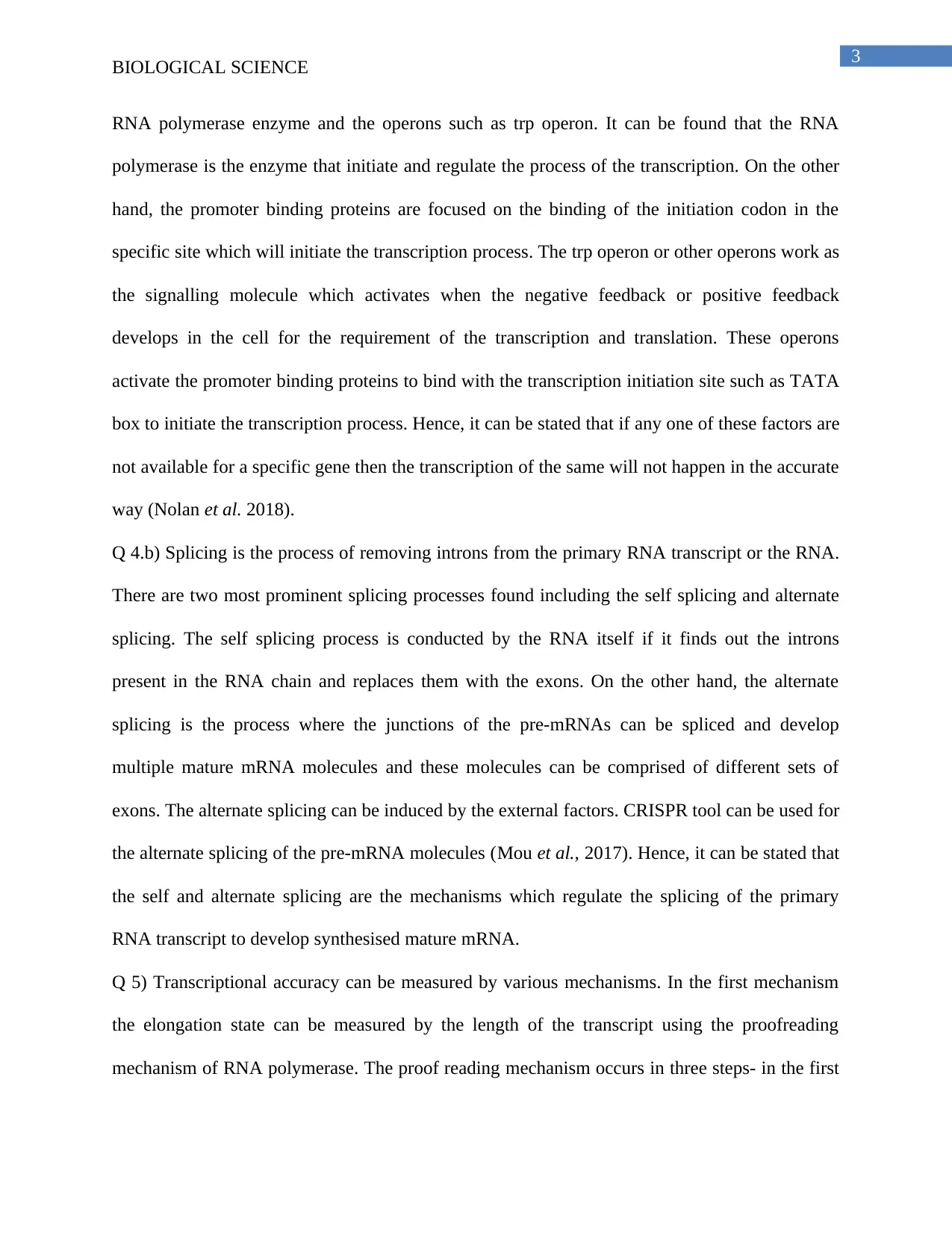
3
BIOLOGICAL SCIENCE
RNA polymerase enzyme and the operons such as trp operon. It can be found that the RNA
polymerase is the enzyme that initiate and regulate the process of the transcription. On the other
hand, the promoter binding proteins are focused on the binding of the initiation codon in the
specific site which will initiate the transcription process. The trp operon or other operons work as
the signalling molecule which activates when the negative feedback or positive feedback
develops in the cell for the requirement of the transcription and translation. These operons
activate the promoter binding proteins to bind with the transcription initiation site such as TATA
box to initiate the transcription process. Hence, it can be stated that if any one of these factors are
not available for a specific gene then the transcription of the same will not happen in the accurate
way (Nolan et al. 2018).
Q 4.b) Splicing is the process of removing introns from the primary RNA transcript or the RNA.
There are two most prominent splicing processes found including the self splicing and alternate
splicing. The self splicing process is conducted by the RNA itself if it finds out the introns
present in the RNA chain and replaces them with the exons. On the other hand, the alternate
splicing is the process where the junctions of the pre-mRNAs can be spliced and develop
multiple mature mRNA molecules and these molecules can be comprised of different sets of
exons. The alternate splicing can be induced by the external factors. CRISPR tool can be used for
the alternate splicing of the pre-mRNA molecules (Mou et al., 2017). Hence, it can be stated that
the self and alternate splicing are the mechanisms which regulate the splicing of the primary
RNA transcript to develop synthesised mature mRNA.
Q 5) Transcriptional accuracy can be measured by various mechanisms. In the first mechanism
the elongation state can be measured by the length of the transcript using the proofreading
mechanism of RNA polymerase. The proof reading mechanism occurs in three steps- in the first
BIOLOGICAL SCIENCE
RNA polymerase enzyme and the operons such as trp operon. It can be found that the RNA
polymerase is the enzyme that initiate and regulate the process of the transcription. On the other
hand, the promoter binding proteins are focused on the binding of the initiation codon in the
specific site which will initiate the transcription process. The trp operon or other operons work as
the signalling molecule which activates when the negative feedback or positive feedback
develops in the cell for the requirement of the transcription and translation. These operons
activate the promoter binding proteins to bind with the transcription initiation site such as TATA
box to initiate the transcription process. Hence, it can be stated that if any one of these factors are
not available for a specific gene then the transcription of the same will not happen in the accurate
way (Nolan et al. 2018).
Q 4.b) Splicing is the process of removing introns from the primary RNA transcript or the RNA.
There are two most prominent splicing processes found including the self splicing and alternate
splicing. The self splicing process is conducted by the RNA itself if it finds out the introns
present in the RNA chain and replaces them with the exons. On the other hand, the alternate
splicing is the process where the junctions of the pre-mRNAs can be spliced and develop
multiple mature mRNA molecules and these molecules can be comprised of different sets of
exons. The alternate splicing can be induced by the external factors. CRISPR tool can be used for
the alternate splicing of the pre-mRNA molecules (Mou et al., 2017). Hence, it can be stated that
the self and alternate splicing are the mechanisms which regulate the splicing of the primary
RNA transcript to develop synthesised mature mRNA.
Q 5) Transcriptional accuracy can be measured by various mechanisms. In the first mechanism
the elongation state can be measured by the length of the transcript using the proofreading
mechanism of RNA polymerase. The proof reading mechanism occurs in three steps- in the first
Paraphrase This Document
Need a fresh take? Get an instant paraphrase of this document with our AI Paraphraser
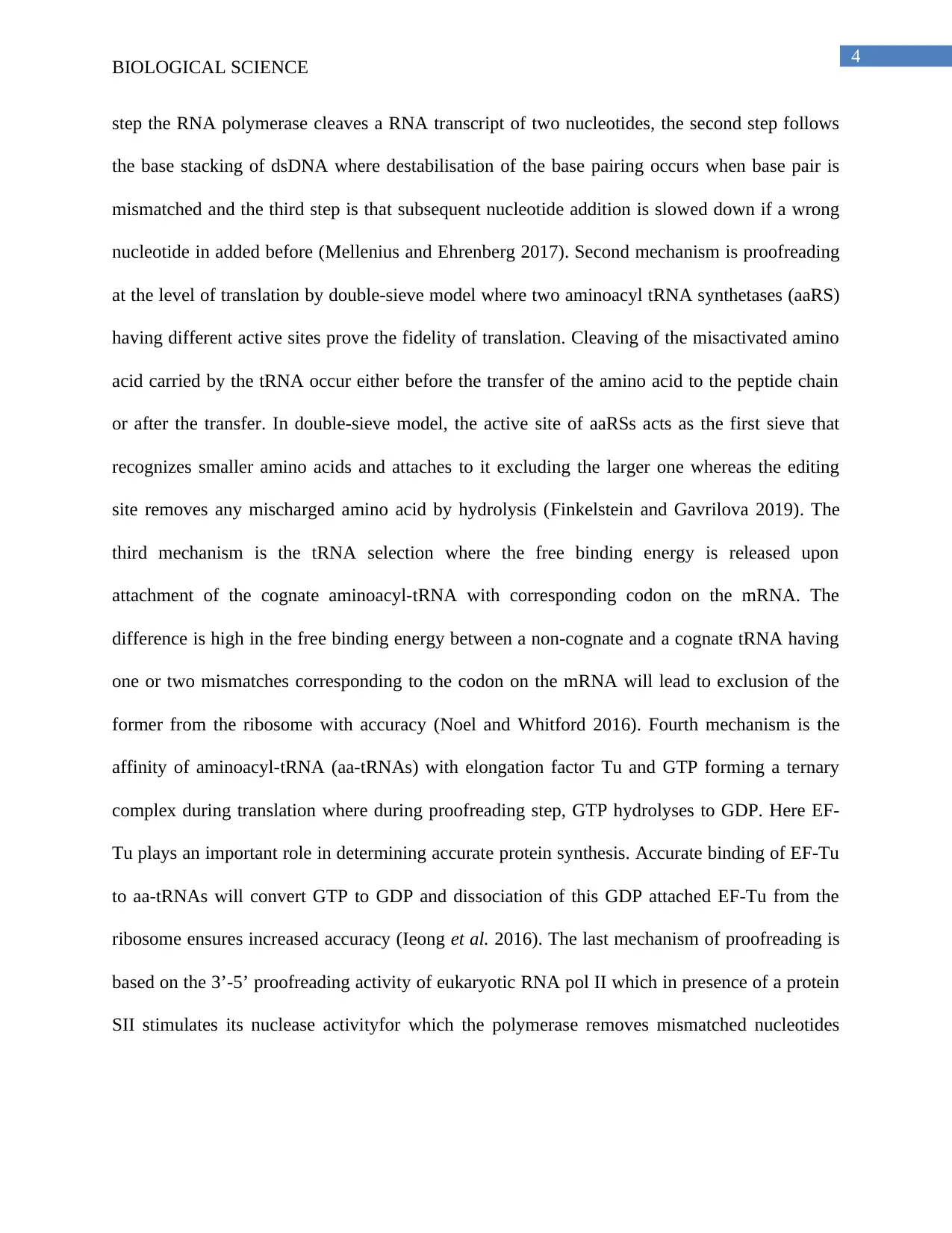
4
BIOLOGICAL SCIENCE
step the RNA polymerase cleaves a RNA transcript of two nucleotides, the second step follows
the base stacking of dsDNA where destabilisation of the base pairing occurs when base pair is
mismatched and the third step is that subsequent nucleotide addition is slowed down if a wrong
nucleotide in added before (Mellenius and Ehrenberg 2017). Second mechanism is proofreading
at the level of translation by double-sieve model where two aminoacyl tRNA synthetases (aaRS)
having different active sites prove the fidelity of translation. Cleaving of the misactivated amino
acid carried by the tRNA occur either before the transfer of the amino acid to the peptide chain
or after the transfer. In double-sieve model, the active site of aaRSs acts as the first sieve that
recognizes smaller amino acids and attaches to it excluding the larger one whereas the editing
site removes any mischarged amino acid by hydrolysis (Finkelstein and Gavrilova 2019). The
third mechanism is the tRNA selection where the free binding energy is released upon
attachment of the cognate aminoacyl-tRNA with corresponding codon on the mRNA. The
difference is high in the free binding energy between a non-cognate and a cognate tRNA having
one or two mismatches corresponding to the codon on the mRNA will lead to exclusion of the
former from the ribosome with accuracy (Noel and Whitford 2016). Fourth mechanism is the
affinity of aminoacyl-tRNA (aa-tRNAs) with elongation factor Tu and GTP forming a ternary
complex during translation where during proofreading step, GTP hydrolyses to GDP. Here EF-
Tu plays an important role in determining accurate protein synthesis. Accurate binding of EF-Tu
to aa-tRNAs will convert GTP to GDP and dissociation of this GDP attached EF-Tu from the
ribosome ensures increased accuracy (Ieong et al. 2016). The last mechanism of proofreading is
based on the 3’-5’ proofreading activity of eukaryotic RNA pol II which in presence of a protein
SII stimulates its nuclease activityfor which the polymerase removes mismatched nucleotides
BIOLOGICAL SCIENCE
step the RNA polymerase cleaves a RNA transcript of two nucleotides, the second step follows
the base stacking of dsDNA where destabilisation of the base pairing occurs when base pair is
mismatched and the third step is that subsequent nucleotide addition is slowed down if a wrong
nucleotide in added before (Mellenius and Ehrenberg 2017). Second mechanism is proofreading
at the level of translation by double-sieve model where two aminoacyl tRNA synthetases (aaRS)
having different active sites prove the fidelity of translation. Cleaving of the misactivated amino
acid carried by the tRNA occur either before the transfer of the amino acid to the peptide chain
or after the transfer. In double-sieve model, the active site of aaRSs acts as the first sieve that
recognizes smaller amino acids and attaches to it excluding the larger one whereas the editing
site removes any mischarged amino acid by hydrolysis (Finkelstein and Gavrilova 2019). The
third mechanism is the tRNA selection where the free binding energy is released upon
attachment of the cognate aminoacyl-tRNA with corresponding codon on the mRNA. The
difference is high in the free binding energy between a non-cognate and a cognate tRNA having
one or two mismatches corresponding to the codon on the mRNA will lead to exclusion of the
former from the ribosome with accuracy (Noel and Whitford 2016). Fourth mechanism is the
affinity of aminoacyl-tRNA (aa-tRNAs) with elongation factor Tu and GTP forming a ternary
complex during translation where during proofreading step, GTP hydrolyses to GDP. Here EF-
Tu plays an important role in determining accurate protein synthesis. Accurate binding of EF-Tu
to aa-tRNAs will convert GTP to GDP and dissociation of this GDP attached EF-Tu from the
ribosome ensures increased accuracy (Ieong et al. 2016). The last mechanism of proofreading is
based on the 3’-5’ proofreading activity of eukaryotic RNA pol II which in presence of a protein
SII stimulates its nuclease activityfor which the polymerase removes mismatched nucleotides
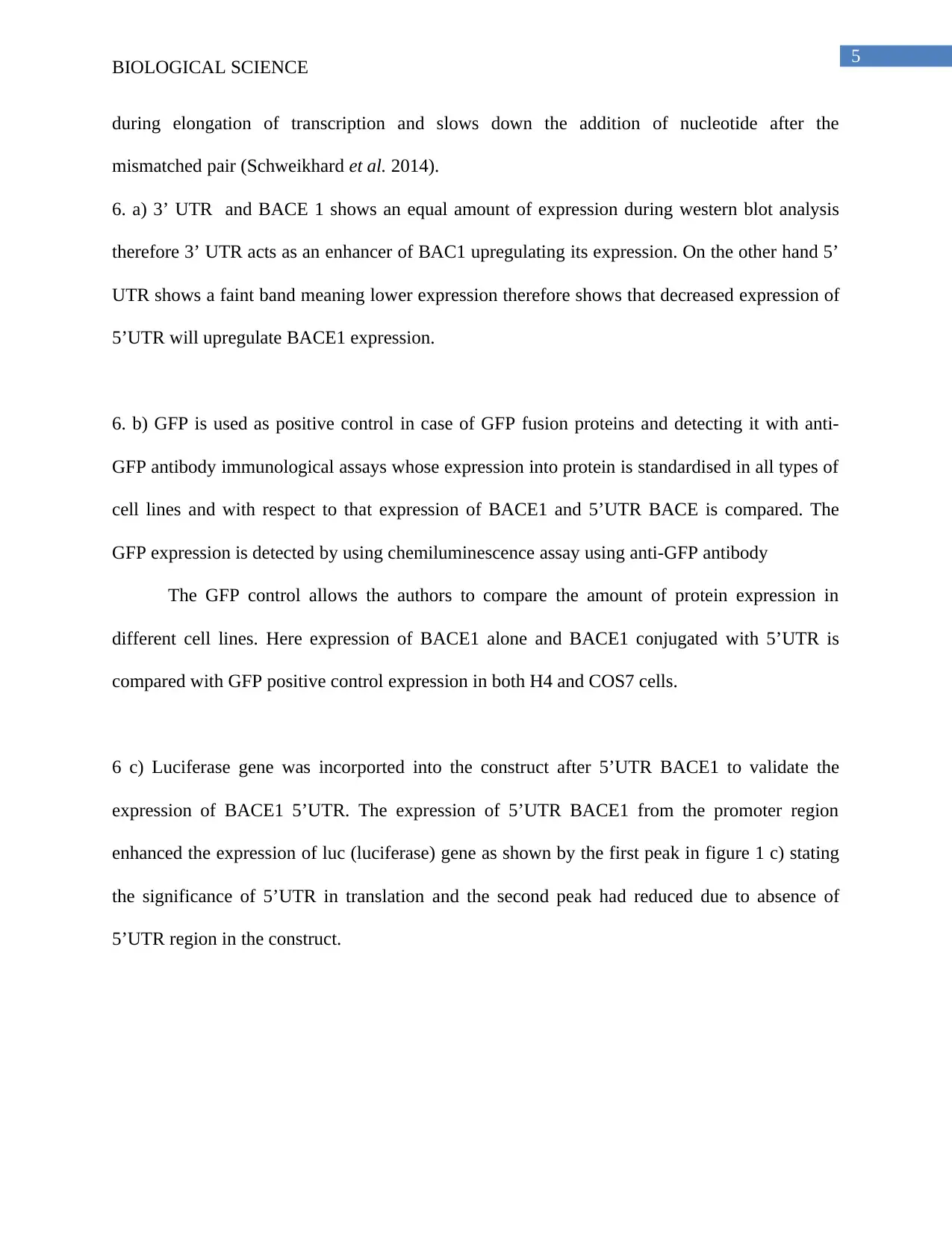
5
BIOLOGICAL SCIENCE
during elongation of transcription and slows down the addition of nucleotide after the
mismatched pair (Schweikhard et al. 2014).
6. a) 3’ UTR and BACE 1 shows an equal amount of expression during western blot analysis
therefore 3’ UTR acts as an enhancer of BAC1 upregulating its expression. On the other hand 5’
UTR shows a faint band meaning lower expression therefore shows that decreased expression of
5’UTR will upregulate BACE1 expression.
6. b) GFP is used as positive control in case of GFP fusion proteins and detecting it with anti-
GFP antibody immunological assays whose expression into protein is standardised in all types of
cell lines and with respect to that expression of BACE1 and 5’UTR BACE is compared. The
GFP expression is detected by using chemiluminescence assay using anti-GFP antibody
The GFP control allows the authors to compare the amount of protein expression in
different cell lines. Here expression of BACE1 alone and BACE1 conjugated with 5’UTR is
compared with GFP positive control expression in both H4 and COS7 cells.
6 c) Luciferase gene was incorported into the construct after 5’UTR BACE1 to validate the
expression of BACE1 5’UTR. The expression of 5’UTR BACE1 from the promoter region
enhanced the expression of luc (luciferase) gene as shown by the first peak in figure 1 c) stating
the significance of 5’UTR in translation and the second peak had reduced due to absence of
5’UTR region in the construct.
BIOLOGICAL SCIENCE
during elongation of transcription and slows down the addition of nucleotide after the
mismatched pair (Schweikhard et al. 2014).
6. a) 3’ UTR and BACE 1 shows an equal amount of expression during western blot analysis
therefore 3’ UTR acts as an enhancer of BAC1 upregulating its expression. On the other hand 5’
UTR shows a faint band meaning lower expression therefore shows that decreased expression of
5’UTR will upregulate BACE1 expression.
6. b) GFP is used as positive control in case of GFP fusion proteins and detecting it with anti-
GFP antibody immunological assays whose expression into protein is standardised in all types of
cell lines and with respect to that expression of BACE1 and 5’UTR BACE is compared. The
GFP expression is detected by using chemiluminescence assay using anti-GFP antibody
The GFP control allows the authors to compare the amount of protein expression in
different cell lines. Here expression of BACE1 alone and BACE1 conjugated with 5’UTR is
compared with GFP positive control expression in both H4 and COS7 cells.
6 c) Luciferase gene was incorported into the construct after 5’UTR BACE1 to validate the
expression of BACE1 5’UTR. The expression of 5’UTR BACE1 from the promoter region
enhanced the expression of luc (luciferase) gene as shown by the first peak in figure 1 c) stating
the significance of 5’UTR in translation and the second peak had reduced due to absence of
5’UTR region in the construct.
⊘ This is a preview!⊘
Do you want full access?
Subscribe today to unlock all pages.

Trusted by 1+ million students worldwide
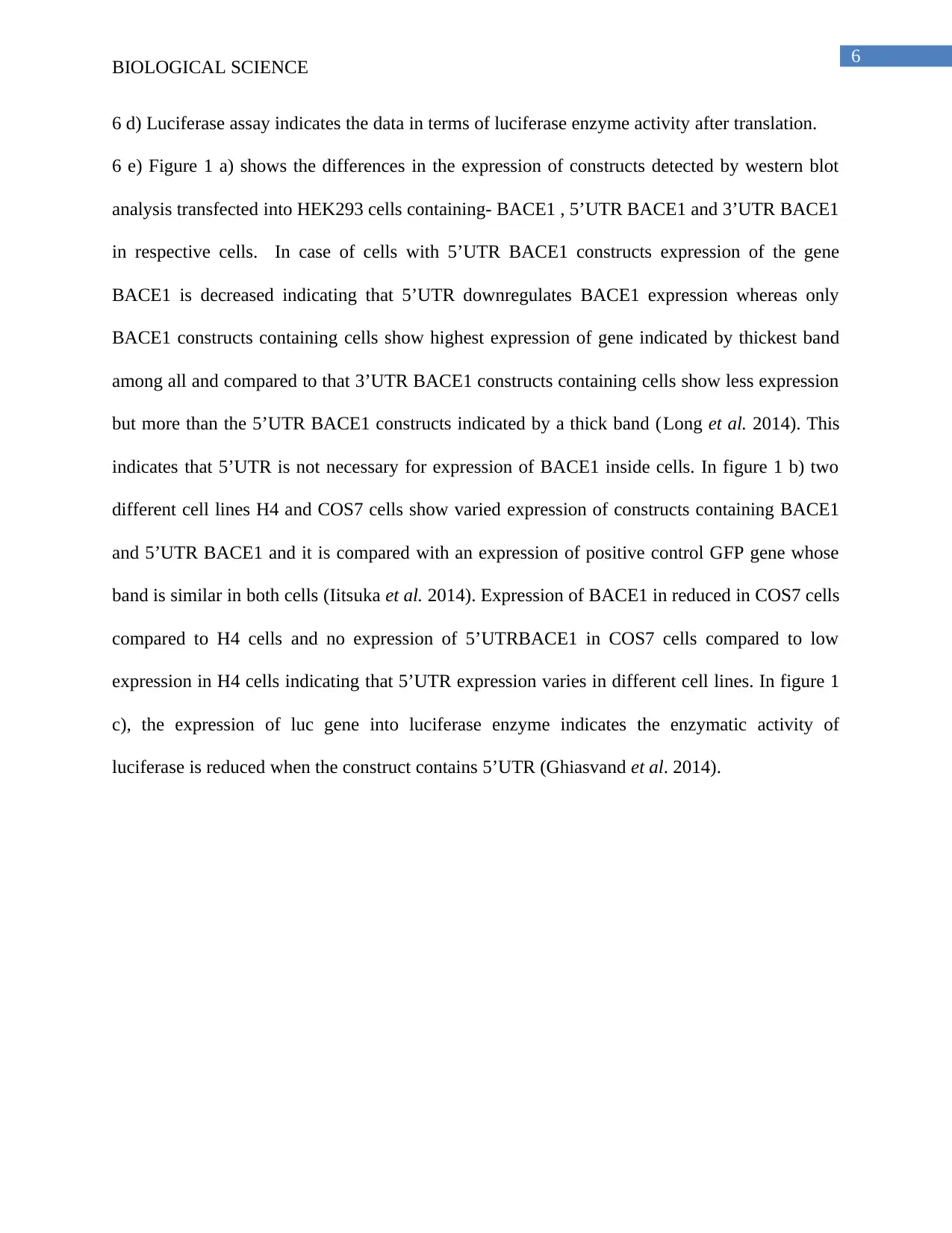
6
BIOLOGICAL SCIENCE
6 d) Luciferase assay indicates the data in terms of luciferase enzyme activity after translation.
6 e) Figure 1 a) shows the differences in the expression of constructs detected by western blot
analysis transfected into HEK293 cells containing- BACE1 , 5’UTR BACE1 and 3’UTR BACE1
in respective cells. In case of cells with 5’UTR BACE1 constructs expression of the gene
BACE1 is decreased indicating that 5’UTR downregulates BACE1 expression whereas only
BACE1 constructs containing cells show highest expression of gene indicated by thickest band
among all and compared to that 3’UTR BACE1 constructs containing cells show less expression
but more than the 5’UTR BACE1 constructs indicated by a thick band (Long et al. 2014). This
indicates that 5’UTR is not necessary for expression of BACE1 inside cells. In figure 1 b) two
different cell lines H4 and COS7 cells show varied expression of constructs containing BACE1
and 5’UTR BACE1 and it is compared with an expression of positive control GFP gene whose
band is similar in both cells (Iitsuka et al. 2014). Expression of BACE1 in reduced in COS7 cells
compared to H4 cells and no expression of 5’UTRBACE1 in COS7 cells compared to low
expression in H4 cells indicating that 5’UTR expression varies in different cell lines. In figure 1
c), the expression of luc gene into luciferase enzyme indicates the enzymatic activity of
luciferase is reduced when the construct contains 5’UTR (Ghiasvand et al. 2014).
BIOLOGICAL SCIENCE
6 d) Luciferase assay indicates the data in terms of luciferase enzyme activity after translation.
6 e) Figure 1 a) shows the differences in the expression of constructs detected by western blot
analysis transfected into HEK293 cells containing- BACE1 , 5’UTR BACE1 and 3’UTR BACE1
in respective cells. In case of cells with 5’UTR BACE1 constructs expression of the gene
BACE1 is decreased indicating that 5’UTR downregulates BACE1 expression whereas only
BACE1 constructs containing cells show highest expression of gene indicated by thickest band
among all and compared to that 3’UTR BACE1 constructs containing cells show less expression
but more than the 5’UTR BACE1 constructs indicated by a thick band (Long et al. 2014). This
indicates that 5’UTR is not necessary for expression of BACE1 inside cells. In figure 1 b) two
different cell lines H4 and COS7 cells show varied expression of constructs containing BACE1
and 5’UTR BACE1 and it is compared with an expression of positive control GFP gene whose
band is similar in both cells (Iitsuka et al. 2014). Expression of BACE1 in reduced in COS7 cells
compared to H4 cells and no expression of 5’UTRBACE1 in COS7 cells compared to low
expression in H4 cells indicating that 5’UTR expression varies in different cell lines. In figure 1
c), the expression of luc gene into luciferase enzyme indicates the enzymatic activity of
luciferase is reduced when the construct contains 5’UTR (Ghiasvand et al. 2014).
Paraphrase This Document
Need a fresh take? Get an instant paraphrase of this document with our AI Paraphraser
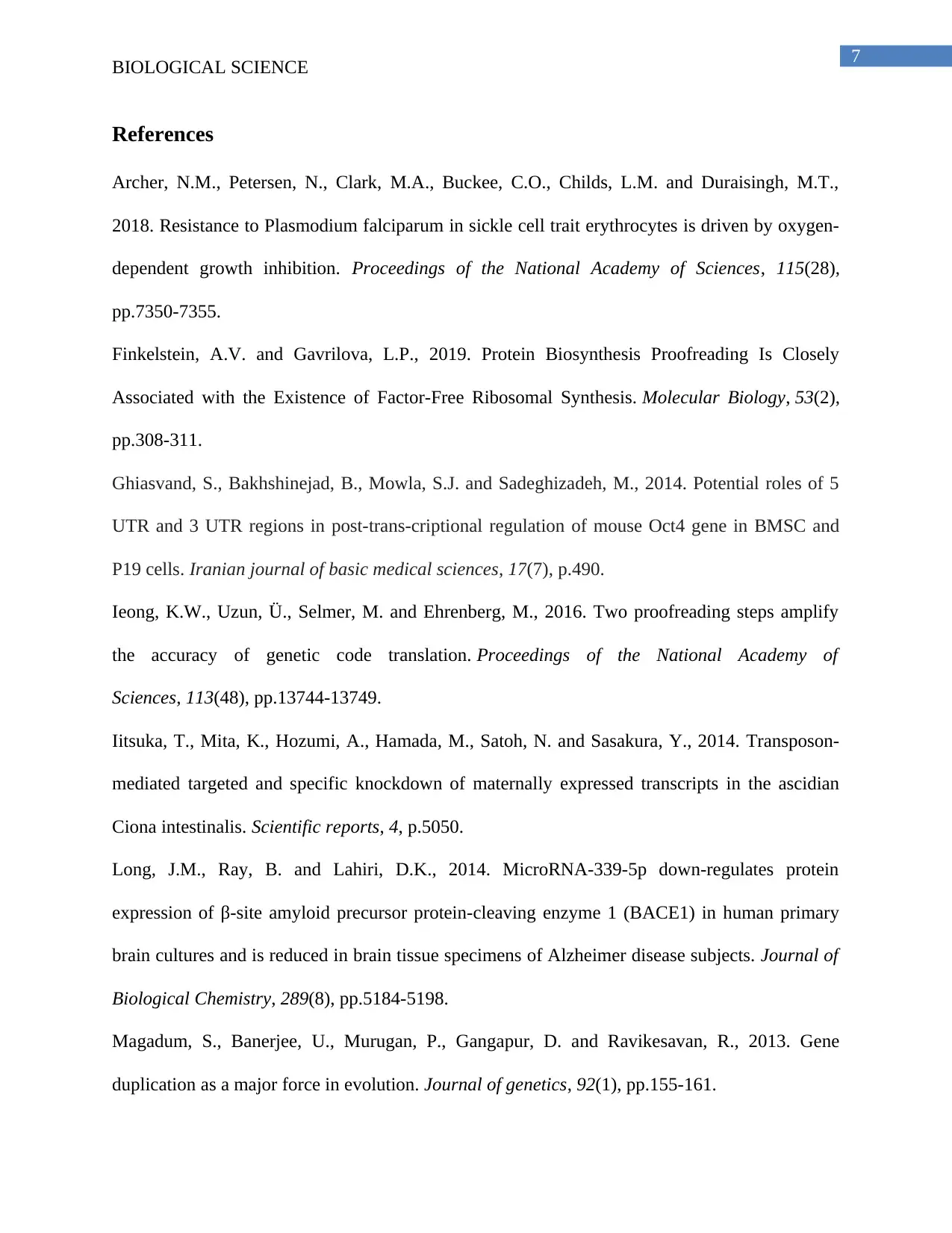
7
BIOLOGICAL SCIENCE
References
Archer, N.M., Petersen, N., Clark, M.A., Buckee, C.O., Childs, L.M. and Duraisingh, M.T.,
2018. Resistance to Plasmodium falciparum in sickle cell trait erythrocytes is driven by oxygen-
dependent growth inhibition. Proceedings of the National Academy of Sciences, 115(28),
pp.7350-7355.
Finkelstein, A.V. and Gavrilova, L.P., 2019. Protein Biosynthesis Proofreading Is Closely
Associated with the Existence of Factor-Free Ribosomal Synthesis. Molecular Biology, 53(2),
pp.308-311.
Ghiasvand, S., Bakhshinejad, B., Mowla, S.J. and Sadeghizadeh, M., 2014. Potential roles of 5
UTR and 3 UTR regions in post-trans-criptional regulation of mouse Oct4 gene in BMSC and
P19 cells. Iranian journal of basic medical sciences, 17(7), p.490.
Ieong, K.W., Uzun, Ü., Selmer, M. and Ehrenberg, M., 2016. Two proofreading steps amplify
the accuracy of genetic code translation. Proceedings of the National Academy of
Sciences, 113(48), pp.13744-13749.
Iitsuka, T., Mita, K., Hozumi, A., Hamada, M., Satoh, N. and Sasakura, Y., 2014. Transposon-
mediated targeted and specific knockdown of maternally expressed transcripts in the ascidian
Ciona intestinalis. Scientific reports, 4, p.5050.
Long, J.M., Ray, B. and Lahiri, D.K., 2014. MicroRNA-339-5p down-regulates protein
expression of β-site amyloid precursor protein-cleaving enzyme 1 (BACE1) in human primary
brain cultures and is reduced in brain tissue specimens of Alzheimer disease subjects. Journal of
Biological Chemistry, 289(8), pp.5184-5198.
Magadum, S., Banerjee, U., Murugan, P., Gangapur, D. and Ravikesavan, R., 2013. Gene
duplication as a major force in evolution. Journal of genetics, 92(1), pp.155-161.
BIOLOGICAL SCIENCE
References
Archer, N.M., Petersen, N., Clark, M.A., Buckee, C.O., Childs, L.M. and Duraisingh, M.T.,
2018. Resistance to Plasmodium falciparum in sickle cell trait erythrocytes is driven by oxygen-
dependent growth inhibition. Proceedings of the National Academy of Sciences, 115(28),
pp.7350-7355.
Finkelstein, A.V. and Gavrilova, L.P., 2019. Protein Biosynthesis Proofreading Is Closely
Associated with the Existence of Factor-Free Ribosomal Synthesis. Molecular Biology, 53(2),
pp.308-311.
Ghiasvand, S., Bakhshinejad, B., Mowla, S.J. and Sadeghizadeh, M., 2014. Potential roles of 5
UTR and 3 UTR regions in post-trans-criptional regulation of mouse Oct4 gene in BMSC and
P19 cells. Iranian journal of basic medical sciences, 17(7), p.490.
Ieong, K.W., Uzun, Ü., Selmer, M. and Ehrenberg, M., 2016. Two proofreading steps amplify
the accuracy of genetic code translation. Proceedings of the National Academy of
Sciences, 113(48), pp.13744-13749.
Iitsuka, T., Mita, K., Hozumi, A., Hamada, M., Satoh, N. and Sasakura, Y., 2014. Transposon-
mediated targeted and specific knockdown of maternally expressed transcripts in the ascidian
Ciona intestinalis. Scientific reports, 4, p.5050.
Long, J.M., Ray, B. and Lahiri, D.K., 2014. MicroRNA-339-5p down-regulates protein
expression of β-site amyloid precursor protein-cleaving enzyme 1 (BACE1) in human primary
brain cultures and is reduced in brain tissue specimens of Alzheimer disease subjects. Journal of
Biological Chemistry, 289(8), pp.5184-5198.
Magadum, S., Banerjee, U., Murugan, P., Gangapur, D. and Ravikesavan, R., 2013. Gene
duplication as a major force in evolution. Journal of genetics, 92(1), pp.155-161.
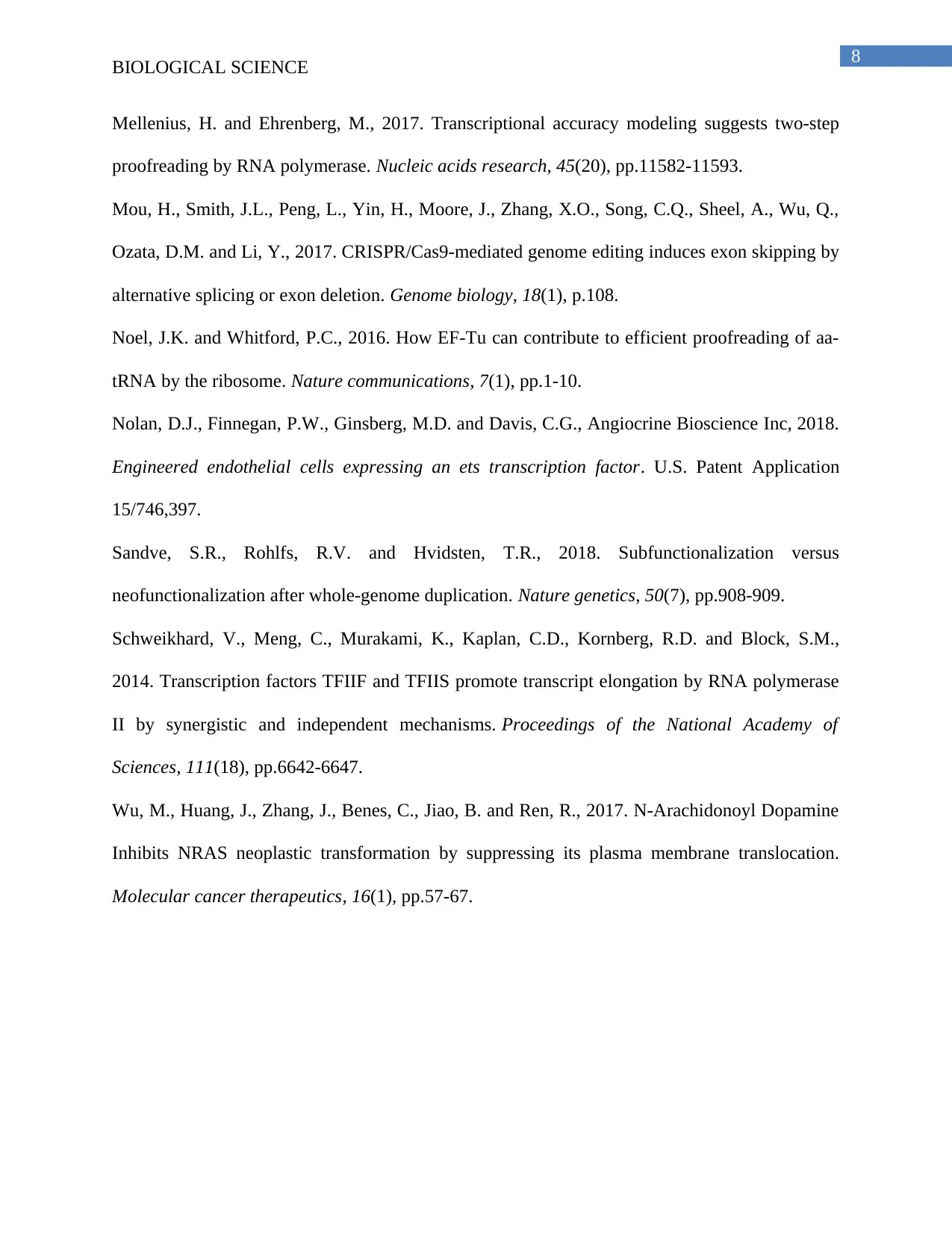
8
BIOLOGICAL SCIENCE
Mellenius, H. and Ehrenberg, M., 2017. Transcriptional accuracy modeling suggests two-step
proofreading by RNA polymerase. Nucleic acids research, 45(20), pp.11582-11593.
Mou, H., Smith, J.L., Peng, L., Yin, H., Moore, J., Zhang, X.O., Song, C.Q., Sheel, A., Wu, Q.,
Ozata, D.M. and Li, Y., 2017. CRISPR/Cas9-mediated genome editing induces exon skipping by
alternative splicing or exon deletion. Genome biology, 18(1), p.108.
Noel, J.K. and Whitford, P.C., 2016. How EF-Tu can contribute to efficient proofreading of aa-
tRNA by the ribosome. Nature communications, 7(1), pp.1-10.
Nolan, D.J., Finnegan, P.W., Ginsberg, M.D. and Davis, C.G., Angiocrine Bioscience Inc, 2018.
Engineered endothelial cells expressing an ets transcription factor. U.S. Patent Application
15/746,397.
Sandve, S.R., Rohlfs, R.V. and Hvidsten, T.R., 2018. Subfunctionalization versus
neofunctionalization after whole-genome duplication. Nature genetics, 50(7), pp.908-909.
Schweikhard, V., Meng, C., Murakami, K., Kaplan, C.D., Kornberg, R.D. and Block, S.M.,
2014. Transcription factors TFIIF and TFIIS promote transcript elongation by RNA polymerase
II by synergistic and independent mechanisms. Proceedings of the National Academy of
Sciences, 111(18), pp.6642-6647.
Wu, M., Huang, J., Zhang, J., Benes, C., Jiao, B. and Ren, R., 2017. N-Arachidonoyl Dopamine
Inhibits NRAS neoplastic transformation by suppressing its plasma membrane translocation.
Molecular cancer therapeutics, 16(1), pp.57-67.
BIOLOGICAL SCIENCE
Mellenius, H. and Ehrenberg, M., 2017. Transcriptional accuracy modeling suggests two-step
proofreading by RNA polymerase. Nucleic acids research, 45(20), pp.11582-11593.
Mou, H., Smith, J.L., Peng, L., Yin, H., Moore, J., Zhang, X.O., Song, C.Q., Sheel, A., Wu, Q.,
Ozata, D.M. and Li, Y., 2017. CRISPR/Cas9-mediated genome editing induces exon skipping by
alternative splicing or exon deletion. Genome biology, 18(1), p.108.
Noel, J.K. and Whitford, P.C., 2016. How EF-Tu can contribute to efficient proofreading of aa-
tRNA by the ribosome. Nature communications, 7(1), pp.1-10.
Nolan, D.J., Finnegan, P.W., Ginsberg, M.D. and Davis, C.G., Angiocrine Bioscience Inc, 2018.
Engineered endothelial cells expressing an ets transcription factor. U.S. Patent Application
15/746,397.
Sandve, S.R., Rohlfs, R.V. and Hvidsten, T.R., 2018. Subfunctionalization versus
neofunctionalization after whole-genome duplication. Nature genetics, 50(7), pp.908-909.
Schweikhard, V., Meng, C., Murakami, K., Kaplan, C.D., Kornberg, R.D. and Block, S.M.,
2014. Transcription factors TFIIF and TFIIS promote transcript elongation by RNA polymerase
II by synergistic and independent mechanisms. Proceedings of the National Academy of
Sciences, 111(18), pp.6642-6647.
Wu, M., Huang, J., Zhang, J., Benes, C., Jiao, B. and Ren, R., 2017. N-Arachidonoyl Dopamine
Inhibits NRAS neoplastic transformation by suppressing its plasma membrane translocation.
Molecular cancer therapeutics, 16(1), pp.57-67.
⊘ This is a preview!⊘
Do you want full access?
Subscribe today to unlock all pages.

Trusted by 1+ million students worldwide
1 out of 9
Related Documents
Your All-in-One AI-Powered Toolkit for Academic Success.
+13062052269
info@desklib.com
Available 24*7 on WhatsApp / Email
![[object Object]](/_next/static/media/star-bottom.7253800d.svg)
Unlock your academic potential
Copyright © 2020–2025 A2Z Services. All Rights Reserved. Developed and managed by ZUCOL.





